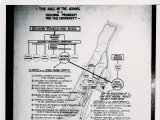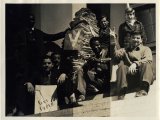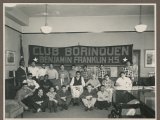You are here:
Benjamin Franklin High School
East Harlem in the 1930s and 1940s was a dense urban community with people from all over the world. Italian-Americans whose families had been in New York one or two generations or had just arrived, Puerto Ricans who came from the island seeking more economic opportunity, and Black migrants from the US South and the Caribbean: all converged in East Harlem. Many East Harlemites found crowded and often crumbling housing, and Puerto Rican and Black workers experienced continued racism in industries like the garment trades (where people made and distributed clothing).1
Read More
But some institutions were trying to figure out how to support East Harlem’s communities. Benjamin Franklin High School was one such place. The school’s principal, Leonard Covello, immigrated to the US from Italy as a child. He imagined that a school could be a hub of community life—open to adults as well as children, and responsive to the community’s cultural identity and its needs and desires. He hoped that school could be a place where different community identities could be celebrated while young people also learned to live and work together to improve their lives.2
Documents from Benjamin Franklin High School in these years—when only boys attended the school—give the impression of joyful connections between young people, who were working together on important issues like collecting supplies to support the World War II effort. We also see that Benjamin Franklin High School students accomplished real changes in their community, including getting new and higher-quality public housing built in East Harlem.3
At the same time, though, racist and ableist ideas still shaped the New York City schools, and affected life at Benjamin Franklin. The Board of Education’s 1958 “Puerto Rican Study” tried to determine the average intelligence of Puerto Rican students. Why did they want to do so? It seemed that they wanted to establish whether Puerto Rican students were intellectually capable of benefiting from schooling. For most white students at the time, the assumption was that they were. The Board of Education also talked about speaking Spanish as a “language handicap,” rather than an important skill and part of students’ culture. The way the Board of Education researched and discussed Puerto Rican students shows us how they thought of them as outside of their view of the ideal or normal student.4
-
Michael C. Johanek and John Puckett, Leonard Covello and the Making of Benjamin Franklin High School: Education as If Citizenship Mattered (Philadelphia: Temple University Press, 2007); Sonia Song Ha Lee, Building a Latino Civil Rights Movement (Chapel Hill: University of North Carolina Press, 2014); Lorrin Thomas, Puerto Rican Citizen: History and Political Identity in Twentieth-Century New York City (Chicago: University of Chicago Press, 2010). ↩︎
-
Johanek and Puckett, Leonard Covello and the Making of Benjamin Franklin High School. ↩︎
-
Johanek and Puckett, Leonard Covello and the Making of Benjamin Franklin High School. ↩︎
-
John Cayce Morrison, The Puerto Rican Study, 1953-1957: A Report on the Education and Adjustment of Puerto Rican Pupils in the Public Schools of the City of New York (New York: Board of Education, 1958). ↩︎



